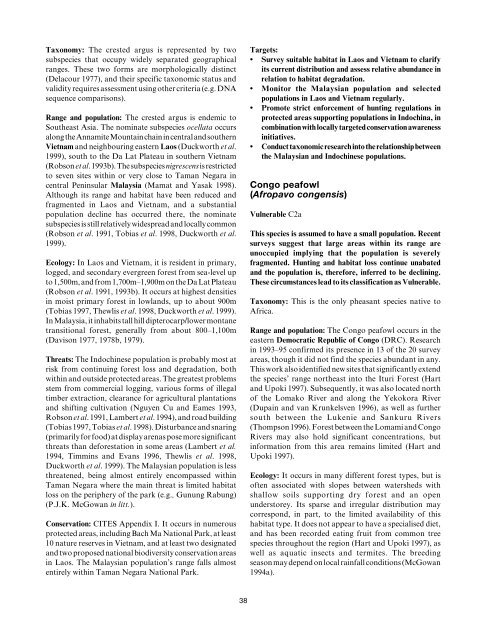Pheasants: Status Survey and Conservation Action Plan ... - IUCN
Pheasants: Status Survey and Conservation Action Plan ... - IUCN
Pheasants: Status Survey and Conservation Action Plan ... - IUCN
Create successful ePaper yourself
Turn your PDF publications into a flip-book with our unique Google optimized e-Paper software.
Taxonomy: The crested argus is represented by two<br />
subspecies that occupy widely separated geographical<br />
ranges. These two forms are morphologically distinct<br />
(Delacour 1977), <strong>and</strong> their specific taxonomic status <strong>and</strong><br />
validity requires assessment using other criteria (e.g. DNA<br />
sequence comparisons).<br />
Range <strong>and</strong> population: The crested argus is endemic to<br />
Southeast Asia. The nominate subspecies ocellata occurs<br />
along the Annamite Mountain chain in central <strong>and</strong> southern<br />
Vietnam <strong>and</strong> neighbouring eastern Laos (Duckworth et al.<br />
1999), south to the Da Lat Plateau in southern Vietnam<br />
(Robson et al. 1993b). The subspecies nigrescens is restricted<br />
to seven sites within or very close to Taman Negara in<br />
central Peninsular Malaysia (Mamat <strong>and</strong> Yasak 1998).<br />
Although its range <strong>and</strong> habitat have been reduced <strong>and</strong><br />
fragmented in Laos <strong>and</strong> Vietnam, <strong>and</strong> a substantial<br />
population decline has occurred there, the nominate<br />
subspecies is still relatively widespread <strong>and</strong> locally common<br />
(Robson et al. 1991, Tobias et al. 1998, Duckworth et al.<br />
1999).<br />
Ecology: In Laos <strong>and</strong> Vietnam, it is resident in primary,<br />
logged, <strong>and</strong> secondary evergreen forest from sea-level up<br />
to 1,500m, <strong>and</strong> from 1,700m–1,900m on the Da Lat Plateau<br />
(Robson et al. 1991, 1993b). It occurs at highest densities<br />
in moist primary forest in lowl<strong>and</strong>s, up to about 900m<br />
(Tobias 1997, Thewlis et al. 1998, Duckworth et al. 1999).<br />
In Malaysia, it inhabits tall hill dipterocarp/lower montane<br />
transitional forest, generally from about 800–1,100m<br />
(Davison 1977, 1978b, 1979).<br />
Threats: The Indochinese population is probably most at<br />
risk from continuing forest loss <strong>and</strong> degradation, both<br />
within <strong>and</strong> outside protected areas. The greatest problems<br />
stem from commercial logging, various forms of illegal<br />
timber extraction, clearance for agricultural plantations<br />
<strong>and</strong> shifting cultivation (Nguyen Cu <strong>and</strong> Eames 1993,<br />
Robson et al. 1991, Lambert et al. 1994), <strong>and</strong> road building<br />
(Tobias 1997, Tobias et al. 1998). Disturbance <strong>and</strong> snaring<br />
(primarily for food) at display arenas pose more significant<br />
threats than deforestation in some areas (Lambert et al.<br />
1994, Timmins <strong>and</strong> Evans 1996, Thewlis et al. 1998,<br />
Duckworth et al. 1999). The Malaysian population is less<br />
threatened, being almost entirely encompassed within<br />
Taman Negara where the main threat is limited habitat<br />
loss on the periphery of the park (e.g., Gunung Rabung)<br />
(P.J.K. McGowan in litt.).<br />
<strong>Conservation</strong>: CITES Appendix I. It occurs in numerous<br />
protected areas, including Bach Ma National Park, at least<br />
10 nature reserves in Vietnam, <strong>and</strong> at least two designated<br />
<strong>and</strong> two proposed national biodiversity conservation areas<br />
in Laos. The Malaysian population’s range falls almost<br />
entirely within Taman Negara National Park.<br />
Targets:<br />
• <strong>Survey</strong> suitable habitat in Laos <strong>and</strong> Vietnam to clarify<br />
its current distribution <strong>and</strong> assess relative abundance in<br />
relation to habitat degradation.<br />
• Monitor the Malaysian population <strong>and</strong> selected<br />
populations in Laos <strong>and</strong> Vietnam regularly.<br />
• Promote strict enforcement of hunting regulations in<br />
protected areas supporting populations in Indochina, in<br />
combination with locally targeted conservation awareness<br />
initiatives.<br />
• Conduct taxonomic research into the relationship between<br />
the Malaysian <strong>and</strong> Indochinese populations.<br />
Congo peafowl<br />
(Afropavo congensis)<br />
Vulnerable C2a<br />
This species is assumed to have a small population. Recent<br />
surveys suggest that large areas within its range are<br />
unoccupied implying that the population is severely<br />
fragmented. Hunting <strong>and</strong> habitat loss continue unabated<br />
<strong>and</strong> the population is, therefore, inferred to be declining.<br />
These circumstances lead to its classification as Vulnerable.<br />
Taxonomy: This is the only pheasant species native to<br />
Africa.<br />
Range <strong>and</strong> population: The Congo peafowl occurs in the<br />
eastern Democratic Republic of Congo (DRC). Research<br />
in 1993–95 confirmed its presence in 13 of the 20 survey<br />
areas, though it did not find the species abundant in any.<br />
This work also identified new sites that significantly extend<br />
the species’ range northeast into the Ituri Forest (Hart<br />
<strong>and</strong> Upoki 1997). Subsequently, it was also located north<br />
of the Lomako River <strong>and</strong> along the Yekokora River<br />
(Dupain <strong>and</strong> van Krunkelsven 1996), as well as further<br />
south between the Lukenie <strong>and</strong> Sankuru Rivers<br />
(Thompson 1996). Forest between the Lomami <strong>and</strong> Congo<br />
Rivers may also hold significant concentrations, but<br />
information from this area remains limited (Hart <strong>and</strong><br />
Upoki 1997).<br />
Ecology: It occurs in many different forest types, but is<br />
often associated with slopes between watersheds with<br />
shallow soils supporting dry forest <strong>and</strong> an open<br />
understorey. Its sparse <strong>and</strong> irregular distribution may<br />
correspond, in part, to the limited availability of this<br />
habitat type. It does not appear to have a specialised diet,<br />
<strong>and</strong> has been recorded eating fruit from common tree<br />
species throughout the region (Hart <strong>and</strong> Upoki 1997), as<br />
well as aquatic insects <strong>and</strong> termites. The breeding<br />
season may depend on local rainfall conditions (McGowan<br />
1994a).<br />
38
















